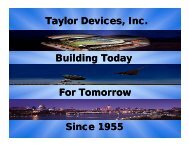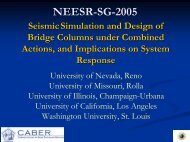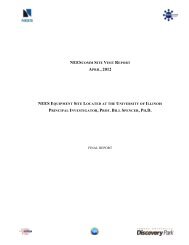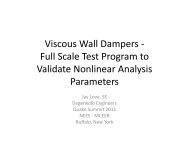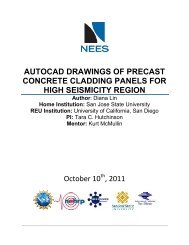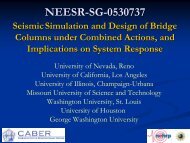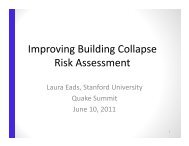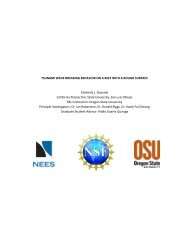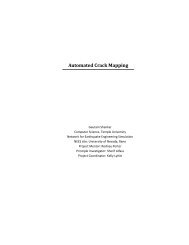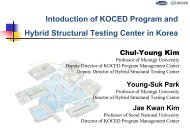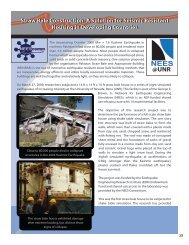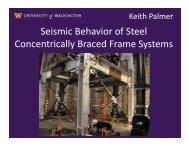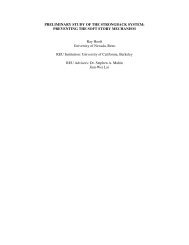UCSD, PCA & NEES BLIND PREDICTION CONTEST
UCSD, PCA & NEES BLIND PREDICTION CONTEST
UCSD, PCA & NEES BLIND PREDICTION CONTEST
You also want an ePaper? Increase the reach of your titles
YUMPU automatically turns print PDFs into web optimized ePapers that Google loves.
<strong>UCSD</strong>, <strong>PCA</strong> & <strong>NEES</strong><br />
<strong>BLIND</strong> <strong>PREDICTION</strong> <strong>CONTEST</strong><br />
Introductory Remarks<br />
Robert Bachman, S.E.<br />
Convener<br />
REBachman Consulting Structural Engineers
Test Facility and Test Structure<br />
• 7 Story full-scale<br />
building slice<br />
• Reinforced concrete<br />
structural wall<br />
• <strong>NEES</strong> Large High-<br />
Performance Outdoor<br />
Shake Table at<br />
<strong>UCSD</strong>’s Englekirk<br />
Structural Engineering<br />
Center
Outline of this Session<br />
• Description of Test Facility, Design of Test Structure and<br />
Testing Program and Discussion of Test Results<br />
• Overview of Blind Prediction Contest, Entries and the<br />
computer platforms they used<br />
• Comparison of Range of Predicted Values with Measured<br />
• Announcement of Winners<br />
• Presentation by Contest Winners of Approach Used
DESCRIPTION OF TEST PROGRAM<br />
Marios Panagiotou, José I. Restrepo,<br />
Joel P. Conte and Robert Englekirk<br />
Department of Structural Engineering<br />
University of California, San Diego
Acknowledgments<br />
• Two-phase Project funded by the Englekirk<br />
Structural Engineering Center Board of Advisors<br />
• Yehuda Bock, SIO, Payload Project Partner<br />
• J.E. Luco, SE <strong>UCSD</strong>, Payload Project Partner and<br />
Advisor<br />
• Ozgur Ozcelik, Graduate Strudent<br />
• Bobak Moaveni, Graduate Student<br />
• The assistance of <strong>NEES</strong>inc, <strong>NEES</strong>it, NSF and of Paul<br />
Somerville (URS Corp.) are greatly appreciated
Englekirk Board of Advisors
Objective<br />
• Verify the seismic performance of medium rise<br />
reinforced concrete residential wall building designed<br />
for lateral forces that are significantly smaller than<br />
those currently specified in building codes in United<br />
States<br />
• UBC 97: Seven story building<br />
• Residential, multi-wall structure<br />
– S c soils<br />
– Site less than 2 km from B fault<br />
– S v = 55 in./sec.<br />
V = 0.29 W Base Shear<br />
Los Angeles
Displacement-based Design<br />
• Two performance levels:<br />
• Immediate occupancy in frequently occurring<br />
earthquakes<br />
• Limited yielding (1% tensile strain maximum)<br />
• Limiting interstory drift ratio<br />
• Life-safety in rare earthquakes (10% in 50)<br />
• Tensile strains less than 5% compressive strain less<br />
than 1%
Displacement-based Design<br />
• Based on initial stiffness and an effective first<br />
mode mass<br />
• Direct use of the Displacement Response Spectra<br />
for elastic response<br />
• Considers the relationship between inelasticelastic<br />
response of SDOF (Miranda – 90 percentile)<br />
• Definition of curvature and displacement ductility<br />
– Strain limits for concrete and reinforcement<br />
– Foundation flexibility<br />
V = 0.15 W Base Shear
Capacity Design<br />
• To guarantee the desired performance at the Lifeprevention<br />
level<br />
• Explicit selection of a mechanism of inelastic<br />
deformation<br />
• Explicit recognition of effects caused higher<br />
modes of response<br />
• Larger than forces obtained from DBD<br />
analysis (1 st mode!)<br />
• Larger floor accelerations
Test Structure<br />
63’-0” 21 m<br />
PT wall<br />
Gravity<br />
columns<br />
Flange wall<br />
Cantilever<br />
web wall<br />
• 7-story building slice with<br />
cantilever wall as the<br />
lateral force resisting<br />
system<br />
• Tallest building structure<br />
ever tested on a<br />
shaketable<br />
• Single axis of input<br />
ground motion in the<br />
plane of the wall<br />
• Phase 1 Testing:<br />
12 ft. long rectangular wall<br />
• Phase 2 Testing<br />
14 ft. 7 in. long T-wall
Design Summary & Detailing<br />
Web Wall Level 1<br />
8” (204 mm)<br />
12’-0” (3.6 m)<br />
ρ l = 0.44% ρ t = 0.31% ρ v = 1.36%<br />
Web Wall Level 2<br />
6” (152 mm)<br />
ρ l = 0.60% ρ t = 0.31% ρ v = 0
Design Summary & Detailing<br />
• Aimed at Construction optimization<br />
– 1 reinforcement curtain in the wall’s web on level 1<br />
– Well confined wall ends<br />
• High-strength Baugrid electro-welded<br />
confinement reinforcement at wall ends<br />
– 1 reinforcement curtain on levels 2-7<br />
– Tunnel form construction<br />
– Concrete with specified compressive strength of<br />
f’ c = 4 ksi (28 MPa)
Test Regime<br />
• Testing at the <strong>NEES</strong>@<strong>UCSD</strong><br />
Large High-Performance Outdoor<br />
Shake Table between October<br />
2005 and January 2006<br />
• Structure tested under increase<br />
intensity historical earthquake<br />
records and with low-intensity<br />
band-clipped white noise in<br />
between earthquake tests<br />
ag (g)<br />
ag (g)<br />
Acceleration ag (g) (g)<br />
ag (g)<br />
1.0<br />
0.8<br />
0.6<br />
0.4<br />
0.2<br />
0.0<br />
-0.2<br />
-0.4<br />
-0.6<br />
-0.8<br />
-1.0<br />
Sf-vnuy-lgn<br />
0.0 5.0 10.0 15.0 20.0<br />
1.0<br />
t (sec)<br />
0.8<br />
Sf-vnuy-tr<br />
0.6<br />
0.4<br />
0.2<br />
0.0<br />
-0.2<br />
-0.4<br />
-0.6<br />
-0.8<br />
-1.0<br />
0.0 5.0 10.0 15.0 20.0<br />
1.0<br />
t (sec)<br />
0.8<br />
0.6<br />
EQ3<br />
Nor-w hox-lgn<br />
0.4<br />
0.2<br />
0.0<br />
-0.2<br />
-0.4<br />
-0.6<br />
-0.8<br />
EQ1<br />
EQ2<br />
-1.0<br />
0.0 5.0 10.0 15.0 20.0<br />
1.0<br />
0.8<br />
t (sec)<br />
0.6<br />
EQ4<br />
Nor-Sylmar-360<br />
0.4<br />
0.2<br />
0.0<br />
-0.2<br />
-0.4<br />
-0.6<br />
-0.8<br />
-1.0<br />
0.00 5.0 10.0 15.0 20 20.0<br />
t (sec)<br />
Time (sec)
Acceleration Response Spectra<br />
2.5<br />
S a (g)<br />
2.0<br />
1.5<br />
1.0<br />
Design<br />
spectra<br />
WN2%g<br />
WN3%g<br />
WN5%g<br />
EQ1<br />
EQ2<br />
EQ3<br />
EQ4<br />
ξ=5%<br />
0.5<br />
0.0<br />
0.0 0.5 1.0 1.5 2.0 2.5 3.0<br />
T (sec)
Sensors<br />
• 600+ sensors deployed on the building, shake<br />
table and surrounding soil<br />
– DC Coupled Accelerometers<br />
– Displacement transducers<br />
– Strain gauges<br />
– Load cells<br />
– Oil pressure transducers<br />
• First time use of 50Hz, 3 mm resolution, real-time<br />
GPS displacement sensors<br />
• 17 videos feeds streamed through <strong>NEES</strong>central
EQ4:<br />
Test EQ4<br />
PGA = 0.93g
EQ4:
Building’s s Response to Sylmar<br />
Earthquake EQ4<br />
• Performance levels anticipated were met:<br />
– Cosmetic damage at the base of the wall<br />
– Reinforcement strains reached 2.7%<br />
– Peak roof-drift ratio was 2.1%<br />
– Residual crack widths less than 1/20 th of an inch<br />
– Negligible residual displacements (1/2 in. at the roof )<br />
• The building slice could perhaps not be<br />
immediately “occupied” but only required<br />
minimum repairs
Data Curing & Archiving<br />
• Significant amount of data has been<br />
collected and is being reduced<br />
• All data and metadata will be archived in<br />
the <strong>NEES</strong> Data Repository and will be<br />
made available to all <strong>NEES</strong> users and<br />
researchers
<strong>BLIND</strong> <strong>PREDICTION</strong> <strong>CONTEST</strong><br />
Scoring, Comparison of Predicted vs Measured<br />
Quantities and Winners<br />
Robert Bachman, S.E.<br />
Convener<br />
REBachman Consulting Structural Engineers
Overview of Contest<br />
• Web site set up – included links to test structure data, test<br />
motions, contest rules, input sheet and questions/answers<br />
• <strong>NEES</strong> email addresses set up for Q/A and entries<br />
• Contest announced March 10 th via electronic communications<br />
(<strong>PCA</strong>, <strong>NEES</strong>, the NSF EQ Centers, EERI), Structural Engineers<br />
Associations – and personal communications<br />
• Q & A posted periodically on web site<br />
• Entries were due electronically May 15 th<br />
• Winners notified by May 25 th
Basic Contest Rules<br />
• Goal – predict responses by analysis - compare with measured<br />
• 3 Categories of teams – Winner <strong>PCA</strong> Award of $ 2500 per team<br />
1. Undergraduates<br />
2. Researchers/Academics<br />
3. Engineering Practitioners<br />
• Predict responses for 4 levels of earthquakes – responses<br />
included displacements, drifts, shears, moments, accelerations<br />
throughout the structures and vertical strains near base.<br />
• Entries judged by determining error in each type of response<br />
Lowest error awarded points. Sum points. Largest sum winner<br />
• The entries were handled confidentially – folks at <strong>UCSD</strong> did not<br />
know who submitted what entries. Relative ranking confidential.
Scoring Procedure - Mean Square root error index<br />
Interstory<br />
Residual<br />
Team i M i V i d i drift ratio displacement<br />
1 0.593 1.228 0.844 0.377 0.514 0.294<br />
2 0.684 1.920 0.984 0.656 0.494 0.445<br />
3 0.653 1.923 0.492 0.454 0.585 0.584<br />
a i<br />
( A − P)<br />
msre<br />
= ∑ ∑<br />
Ai : measured (actual) response quantity<br />
i<br />
A<br />
i<br />
i<br />
2<br />
4 0.656 1.298 0.576 0.823 0.629<br />
0.604<br />
5 0.574 3.173 0.696 1.096 0.633 0.799<br />
Pi : predicted response quantity<br />
Team score<br />
Interstory Residual<br />
Team i M i V i d i ü i / g drift ratio drift ratio*<br />
1 4 8 1 8 4 8<br />
2 0 2 0 2 8 4<br />
3 2 1 8 4 2 2<br />
Total<br />
points<br />
33<br />
16<br />
19<br />
4 1 4 4 1 1<br />
1<br />
12<br />
5<br />
8 0 2 0 0 0<br />
10
Entries / Computer Platforms<br />
• 21 total entries/ 8 countries<br />
• Undergraduates – 2 teams / 2 countries<br />
Countries – Italy and US<br />
Computer Platforms – Etabs and SeismoStruct<br />
• Researchers/Academics – 11 teams / 8 countries<br />
Countries – Canada, France, Italy, Mexico, New Zealand, Slovenia,<br />
Taiwan, US<br />
Computer Platforms: Abaqus, Canny, Column, Fedeas Lab,<br />
Narc2004, OpenSees, Ruaumoko, Sap 2000<br />
• Engineering Practitioners – 8 teams / 2 countries<br />
Countries – New Zealand and US<br />
Computer Platforms: Adina, ANSR-II, Hand Calculator/code<br />
formulas, OpenSees, PC-ANSR, Ram Perform 3-D
Undergraduate Entries<br />
• Italy – Laura Quaglini<br />
Advisor – Dr. Rui Pinho<br />
University of Pavia<br />
• US – Michael Billings, Soyoon Lee and<br />
Evan Peterman<br />
Advisor – Prof. Ansgar Neuenhofer<br />
Cal Poly San Luis Obispo
Researcher/Academic Entries<br />
• Canada – Alireza Ahmdina and Carlos Ventura<br />
• France – Stephane Grane, Panagiotis Kotronis and<br />
Jacky Mazars<br />
• Italy/US – Paolo Martinelli and Filip Filippou<br />
• Mexico – Mario Rodriquez, Roque Sanchez and<br />
Miguel Torres<br />
• New Zealand – Dion Marriot, Kam Yuen Yuen, Stefano<br />
Pampanin and Athol Carr<br />
• Slovenia – Matej Fischinger, Peter Kante and Tatjana<br />
Isakovic<br />
• Taiwan – Kuang-Yen Liu<br />
• US/SUNY Buffalo – Methee Chiewanichakorn and Amjad Aref<br />
• US/Univ of Washington – Blake Doekper, Laura Lowes and Dawn<br />
Lehman<br />
• US/Univ of Missouri at KC – Kavitra Deshmukh, Ganesh<br />
Thiagarajan, Thomas Heausler<br />
• US/Iowa State University – Jon Waugh and Sri Sritharan
Engineering Practitioner Entries<br />
• Nikolay Doumbalski, MMI, Oakland, CA<br />
• Rick Drake, JSDyer, Anaheim, CA<br />
• Mahmoud Hachem, Emeryville, CA<br />
• Jimin Huang, HDR Engr, Minneapolis, Minnesota<br />
• Trevor Kelly, Holmes Consulting Group, New Zealand<br />
• Bruce Maison, EBMUD, El Cerrito, CA<br />
• David Nilles,PE. SE., Washougal, WA<br />
• Jianxia Zhong, Y.L. Mo, Paul Jacob and Turel Gur mostly from<br />
MMI in Houston, Texas
Selected Comparison of Selected Measured<br />
versus Predicted Responses<br />
(Top 4 in Researcher/Academic and Engineer<br />
Practitioner Categories)
7<br />
6<br />
Blind Prediction Results - EQ3 - Shear Force Envelope<br />
First 4 teams of each category<br />
Measured<br />
5<br />
Floor<br />
4<br />
3<br />
2<br />
1<br />
0<br />
0 50 100 150 200 250 300 350<br />
Shear Force (kips)
7<br />
6<br />
Blind Prediction Results - EQ3 - Total Acceleration Envelope<br />
First 4 teams of each category<br />
Measured<br />
5<br />
Floor<br />
4<br />
3<br />
2<br />
1<br />
0<br />
0.0 0.1 0.2 0.3 0.4 0.5 0.6 0.7 0.8 0.9 1.0 1.1 1.2 1.3<br />
Total Acceleration (g)
7<br />
6<br />
Blind Prediction Results - EQ4 - Relative Lateral Displacement<br />
Envelope - First 4 teams of each category<br />
Measured<br />
5<br />
Floor<br />
4<br />
3<br />
2<br />
1<br />
0<br />
0 2 4 6 8 10 12 14 16 18<br />
Relative Lateral Displacement (in)
7<br />
6<br />
Blind Prediction Results - EQ4 - Interstory Drift Ratio Envelope<br />
First 4 teams of each category<br />
Measured<br />
5<br />
Floor<br />
4<br />
3<br />
2<br />
1<br />
0.000 0.005 0.010 0.015 0.020 0.025 0.030<br />
Interstory Drift Ratio
• The M Factor<br />
Key Finding
And the Winners Are –<br />
Drum Roll Please !<br />
Undergraduate Team Winner<br />
Cal Poly San Luis Obispo represented by Michael Billings<br />
Researcher/Academic Team winner<br />
University of Ljubljana, Slovenia<br />
represented by Matej Fischinger<br />
and Engineer Practitioner winner<br />
Mahmoud Hachem of<br />
Wiss, Janney, Elstner, , Emeryville, California



